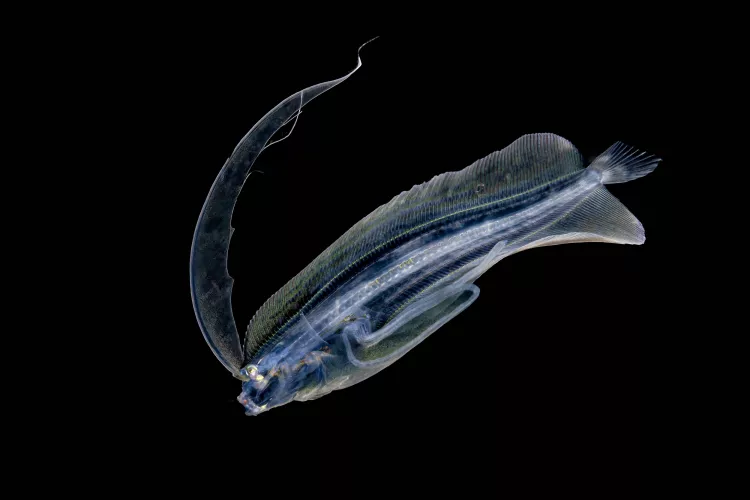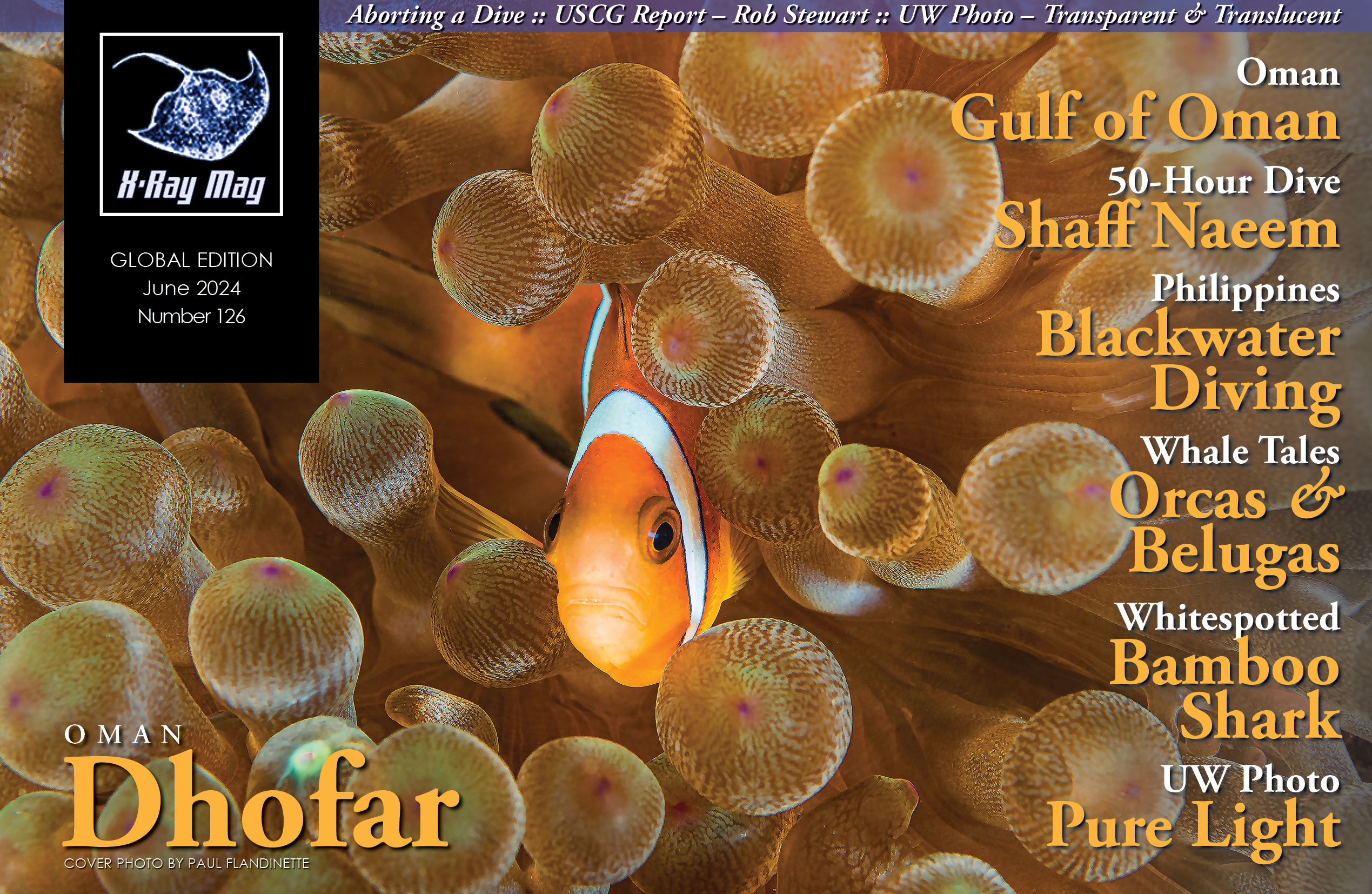The images are what immediately grab your attention—seemingly alien creatures lurking somewhere out there in the dark of night, long after most people have called it a day. Don Silcock takes us on a blackwater dive.
Contributed by
What are these creatures and why are they there? How does it work? Was it all just another clever marketing gimmick to suck you in, or was this thing something really new and compellingly different?
After a lot of discussions with people I trust, it seemed clear that I just had to give it a try, and so at the end of January I took my seat on the Qantas flight to Manila in the Philippines, as I made my way to Anilao—Southeast Asia’s blackwater diving capital!

What is blackwater diving?
Also known as pelagic diving, blackwater is basically night diving on steroids. Sites for traditional night dives are typically chosen because they are in relatively shallow areas that are protected from the elements and provide a reasonably safe location to be underwater at night. Blackwater locations on the other hand are the complete opposite.
They are in open water where there are currents and well away from land with depths of more than 200m! Why, may you ask? Well, this is where those strange creatures are found as they rise from the depths once the sun goes down. The actual dives are typically conducted in the 15 to 25m zone, but the occasional foray deeper does happen when a special visitor appears!

Why are the creatures there?
In much the same way as many of the most special underwater experiences involve entering the water during annual aggregations—such as South Australia’s giant cuttlefish mating season or Tonga’s southern humpback migration—blackwater diving is all about the diel vertical migration (DVM). Virtually unknown outside of the scientific community, DVM was first described by the 19th century French naturalist Georges Cuvier, who noted that a type of plankton called daphnia appeared and disappeared in a diel (daily) pattern.
But DVM is not just another migration; in terms of biomass, it is considered to be the largest synchronous movement of creatures in the world, and it happens every night, in every ocean. So intense is this vertical migration that during WWII, it was detected by sonar by the US Navy and initially interpreted as attacking enemy submarines, but further testing established what was then called the deep scattering layer (DSL), which we now know as the DVM.

DVM for dummies
Every night, as the sun slips below the horizon, an incredible phenomenon unfolds beneath the ocean’s surface. Billions of tiny animals, primarily zooplankton such as small fish, shrimps and jellyfish, along with the juvenile stages of larger creatures, embark on an upward migration from the depths towards the surface.
While the exact reasons for this nightly migration are the subject of many theories, it is widely believed that these creatures ascend to feed in the food-rich surface waters. They do this at night, when light is scarce, because they are less visible to predators that rely on light to hunt.
Theories about the reasons for this migration include circadian rhythms, temperature changes, prey abundance and predation risk. However, the energy-intensive expenditure involved in this movement raises questions about its true purpose. As dawn approaches, the creatures return to the depths, only to return at dusk and repeat this nightly ritual in an intriguing cycle that superbly illustrates the intricate balance of life beneath the ocean’s surface.
Nature’s carbon pump
The abundant food source in the surface layer of our oceans that drives the upward migration of zooplankton, is called phytoplankton. Often referred to as the “plants” of the plankton world, phytoplankton sit at the very bottom of the marine food chain and scientists classify them as “primary producers,” critical to life as we know it.

Phytoplankton thrive at the ocean’s surface, because they can absorb sunlight and use it in a process called photosynthesis to convert carbon dioxide into glucose and oxygen. Thus, carbon dioxide, both organic (from the atmosphere) and inorganic (pollutants from fossil fuels), is removed, glucose is created as an energy source, and oxygen is produced (as a by-product) and released into the atmosphere.
Individually, phytoplankton absorb microscopic amounts of carbon dioxide and release equally small amounts of oxygen, but size matters. There are so many phytoplankton in our oceans that the total amount absorbed and released is at least equal to that of all the plants and trees on land.
So, what happens to the carbondioxide absorbed by phytoplankton? Zooplankton are herbivores and consume phytoplankton in vast quantities, effectively ingesting the carbon dioxide and on return to the depths each morning they release it as organic waste to become part of the ocean floor.
One theory as to why DVM occurs at night is that phytoplankton can use the daylight hours in relative safety to photosynthesise and multiply—nature’s way of ensuring that the basic building block of the marine food chain remains robust and fully functional.

How it works

There are several versions of blackwater diving, starting with the original, pioneered in Kona, Hawaii, where (as I understand it) a lighted “downline” is used, with video lights performing the primary function of attracting the creatures. But you are tethered to the downline and cannot go off-piste even if you wanted to. Plus, you have to be careful not to get entangled with other tethered divers, and your reach is obviously restricted to the length of the tether—so you have to hope that the critters come within that range.
Another version is called the “bonfire” and is apparently done in much shallower water with a powerful light secured to the bottom and shining upwards.
The third version, which I experienced, closely resembles the Kona method, but offers greater freedom of movement. This innovative approach was developed by Mike Bartick of Crystal Blue Resort (CBR) in Anilao, drawing from his extensive experience in adapting blackwater diving to local conditions.
Central to this method is the “pumpkin”—a plastic orange buoy that supports the downline and has its own video light. The 25m long downline is weighted at the end and equipped with powerful video lights every five metres to attract plankton and the intriguing critters that follow.

The pumpkin drifts with the current but is not accelerated by the surface wind as it is when the downline is secured to the boat, so divers in the water can easily keep up with it instead of being left behind in the dark!
The video light on the pumpkin ensures visibility for the boat crew, who maintain a safe distance as they follow the divers. In addition, the lights along the downline serve as reference points for divers in the dark waters below.
The first dive
It starts off with a 7 p.m. departure from the resort, and it can take up to an hour to get to the dive site. By the time the engines are stopped, it is well and truly dark. The crew immediately start preparing and deploying the downline, the video lights and the pumpkin and then it is time to get in the water!
It is hard to properly describe how you feel on that first dive, but “strange” is probably the best way to put it. The combination of being in open water in the compete darkness of night with the downline lights as your only visual point of reference is quite challenging, but what really plays on your mind are the Stephen King-esque imaginings of what is out there in that darkness. Then there is the challenge of trying to photograph what you do see; the Reader’s Digest version is that it is no easy feat!
Each dive has a time limit of one hour and you have to surface near the pumpkin and then signal with your torch as you rotate at the surface, so the boat crew can see that you are up. At first you cannot see the boat, so the sound of its engines as it approaches is very reassuring.
For safety reasons, divers swim away from the pumpkin to be picked up by the boat. After each dive, there is a one-hour surface interval before venturing into the darkness once more. It is not uncommon to return to the resort at around 1:00 in the morning, which is why I call it the Anilao Night Shift.

Is it safe?
Blackwater diving is not something you would consider doing with “Doug’s Discount Diving” as you are definitely near the effective limits of recreational diving. So, it is imperative that you do blackwater diving with an operator that really knows their stuff and has the crew to support it. You also need to be a confident and competent diver with excellent buoyancy control, good self-awareness and a strong sense of adventure.

I was in Anilao for a total of nine days of diving, but the first three involved regular day dives focusing on the general critters the area is known for. Then, on the evening of the third day, I did my first night shift and simply did not bother with day diving after that.
It took me four night shifts to start to get it, and after that there was no looking back. Although I was very much out of my personal comfort zone during those first three days, I never once felt unsafe or in danger. Strange yes, but in danger, no. So yes, I think it’s safe!
To sum up
Reflecting on my experience in Anilao, I realise that blackwater diving was an itch I did not know I needed to scratch—until I did. To be more precise, it is blackwater diving combined with underwater photography that has truly captivated me. The unparalleled visual opportunities it offers are unlike anything I have experienced before. I am already plotting my return for another series of Anilao night shifts and actively scouting other locations to indulge in this truly compelling form of diving. ■
Don Silcock is an underwater photographer and photojournalist based on the island of Bali in Indonesia. Visit his website for extensive location guides, articles and images of some of the best dive locations in the Indo-Pacific region and “big animal” experiences globally. Go to: indopacificimages.com.
Sources:
Bartick M. 2022. The World of Blackwater. Self-published. Apple Books.
Wikipedia.org





























